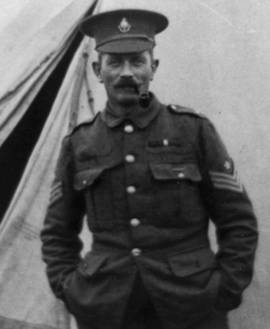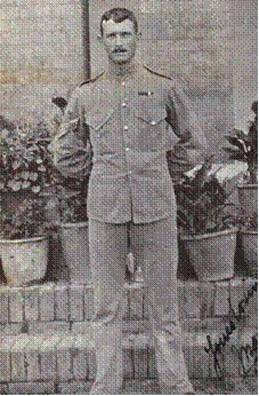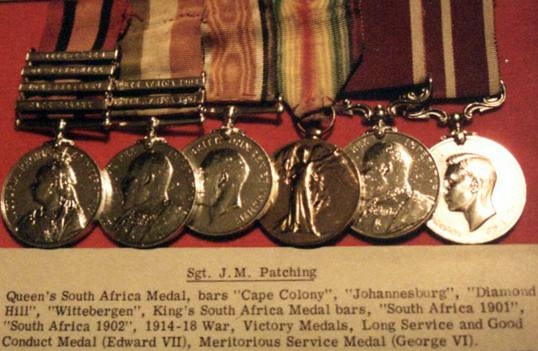
John Marshall Patching was the 5th child of John Marshall Patching and Elizabeth Richardson, and was born 2nd November 1874 at New Shoreham. He was christened the same day, the name on the Baptismal record gives his name as John Marshall Timothy. He was always known as Marsh which distinguished him from his father, but the name Timothy seems to have been forgotten altogether.
Marsh spent his childhood at Portslade where his father was employed as a Brewers Labourer.
Our first knowledge of him is when he was 18 and he enlisted in the 1st Battalion, The Royal Sussex Regiment at Chichester on the 7th November 1892. number 4114.
By 1898 he was a Corporal in ‘A’ Company and was stationed at Aldershot. During this time he met Elizabeth Turk who was a Cook working in Hove. Their courtship must have been restricted to letters as he was seldom home.
At the outbreak of the Boer War in 1899 the 1st Battalion, The Royal Sussex were the Premier Regiment at Aldershot, and thought they should have been the first to go to South Africa. They were greatly disappointed that it was not until October 1899, that the Battalion embarked for Malta, The Battalion was even more cheesed off that they then had to wait in Malta until the following February before finally embarking for South Africa.
They arrived at East London on the 27th march 1900 where they disembarked ‘A’ Company under Major O’Grady. The Battalion then entrained for Bethulie. They started the Trek to Irene on the 29th April when they left Glen. The Battalion received its first casualty at Welkom Farm soon after leaving Glen. Their first large engagement was at Zand River on the 10th May. They reached the railway at Spitz. Kop on 23rd May having marched 25O miles since leaving Glen. Once again they were in action on the 29th May at Doorn Kop. The Battalion ‘a casualty’s since their arrival now totalled 5 kia. and 25 wounded. They entered Pretoria and fought gallantly at Diamond Hill on the 11th and 12th June, Casualty’s for this battle were 2 K.I.A. and 16 wounded and I P.O.W. After so much marching and fighting they were in a sorry state as they had not received any replenishment of kit since starting the Trek, and it was a motley crew who marched into Springs on the 21st June. The Battalion reached Hieleberg on the 26th June where they slept in the Goods Sheds. They rested until the 29th June and received a replenishment of kit before starting the Trek again. The weather was wretched. Or arrival at Retiefs Nek they again saw action and 36 men were wounded, and 4 K.I.A. This action took place on the 23rd July. The Battalion continued marching again and on the 31st July took many prisoners at Klerksvlei. When they reached Geneva Sidings the Battalion split into two, half to go by rail and the other half to march. ‘A’ Company was in the marching group, when they reached Ventersberg road on the 25th August they were sent by special train to Winberg, where they were to relieve a garrison at a farm outside of the town, but the Boer’s had surrendered before they arrived.
The troops returned to Winburg for the night, ‘A’ and ‘F’ Company’s were on outpost duty and were involved in a skirmish at the Sidings.
By the 15th September the Battalion became one unit at Zamen Koust. They Trekked until the 29th September when half the Battalion was left at Lindley, and that night an ‘A’ Company man was shot on duty and two were injured. On the 3rd October ‘A’ and ‘H’ Company’s went to Witt Kop and on the 11th October ‘A’ Company went to Holfontien, Du Moulin, the 2 in command, entrained on the 14th October collecting all the Company’s of the Battalion together again as he passed on up the line, On the 16th October the whole Battalion started marching to Bloemfontein and Kroonstad where over the next few days they evacuated the people of the town, On the 30th October they once again saw action at Ventersburg Road, the Battalion suffering no casualty’s The Battalion was based at Lindley, Treking to and fro but seeing no real action, until 20th January 1901 when they marched to Kroonstad. Company’s ‘A’ ‘C’ ‘D’ ‘F’ and ‘G’ entrained for Ventersburg Road on the 25th January, where they started a convoy. By the time it reached Dewetsdorp on the 16th March the convoy was ten miles long, and the rear guard did not leave camp until two hours after the advance guard reached the next camp. The men of the Royal Sussex Regiment were very pleased, when on the 20th May they stopped convoy work and went out as a fighting force.
May 29th 1901 Royal Sussex Regiment 1st and 3rd battalions meet
(From a correspondent at Norvals point.)
Saturday April 27th was a red letter day in the annuls of the Royal Sussex Regiment, for on that auspicious date the 3rd Militia Battalion were entertained by their comrades of the 1st battalion, the headquarters of which are at present at Norvals point on the orange River frontier. The troop train containing the 3rd battalion was expected in on the Friday evening, and preparations had been made by their comrades of the 1st to give an open-air concert in their honour, but it was not till about 2.30 am on Saturday that the 3rd arrived. Consequently their stay was short ,barely extending over 24 hours. However after a preliminary muster parade the men of the 3rd were allowed to cross the Orange River by the pontoon bridge and visit their comrades on the orange colony side. It was a pity that the majority of the 1st were on outpost duty on the surrounding kopjes as anything in the shape of an organised entertainment was out of the question. Never the less the visit was enjoyed by both units and the sergeants celebrated the meeting by a grand football match. And it was a match! The Sussex senior wasn’t in it!
The teams lined up as follows;
3rd battalion
Sergeants Samways goal, Linfield and King backs, Fuller Keene and Mynett half backs,
Smith and Lawton right wing, Donovan centre, Thorne and Galop left wing forwards.
1st battalion
Sergeants Williamson goal, Patching and Costham backs, Finucane Hastings and Hersee halfbacks,
Smith and Maxfield right wing , Evans centre, Leech and dyer left wing forwards
Referee colour-sergeant Bartholomew Linesman sergeant Pyne [BP] colour-sergeant White and Joe the regimental pet ostrich.
Play commenced sharp at 3 PM, and it was soon apparent that this was to be the match of the season. After a lot of give and take play [chiefly give] the ball was passed to sergeant leech. Who made a most brilliant sprint for quite three yards, but was stopped in his mad flight by Joe the ostrich who evinced a keen interest in the game and was with difficulty restrained from making a meal of the ball. However when it had been ascertained which was Leech and which was Joe play was resumed.
Linfield ran down the field well with the ball and was stopped by Cosham who passed to midfield where it was taken by Maxfield and after another brilliant bout of passing in which the whole of the forwards took part a gaol was scored for the 1st by Evans who struck the upright with a very fast shot and before the goalkeeper could recover himself the ball was headed through by the same player. The 3rd protested against the goal being allowed and as the referee seemed unconvinced someone obligingly “flattened “ him out and the game proceeded merrily sans referee.
At this juncture two transport mules joined in the game which rapidly developed into a balaclava melee, now and again the players mistook the linesman [BP] for the ball and gave him a rough passage from which he emerged with his smasher hat very much smashed. Then half time was sounded and sergeant major Amos took a list of the killed and wounded, after the ground had been cleared of the wreckage play was resumed, the forward line of the first being strengthened by Joe the ostrich who sailed into the fray with gusto. It was rather puzzling at times to locate the players as everyone seemed to be playing on their own. The 3rd goalkeeper Samways was somewhere in the middle of the field spreading death and glory around. The remainder of the team were qualifying for hospital with a zeal that was refreshing to see; even when the ball crossed the line, the crowd of players followed it regardless of the expostulations of BP, and for some minutes there was a wild fracas round the machine gun, when the ball sped that way. The 3rd made noble efforts to score an equalising goal but in vain and at four o clock time was sounded and both sides adjourned to the mess to recover their lost breath. Although the game was not played strictly in accordance with the rules of the NFA still everyone thoroughly enjoyed themselves and a return match will doubtless be played when time and circumstances permit. The destination of the 3rd batt is Bloemfontein, but one cannot say whether they will stay there permanently or not as things are so unsettled. The headquarters and two companies H and D of the 1st batt are still at Norval point the remainder are mounted and under command of Major du Moulin are scouring the colony. There is no news of the move to India.
(The above is from a newspaper of the day and put into a scrap book which has been given to the WSRO.)

The war did not end for another year and the battalions move was a long way off.
Du Moulin had done good work and five Company’s, including ‘A’ Company, went out as a Commando force. Du Moulin Commando unit had 600 men and he made his base at Philippolis, on the 21st July for two months. During this time the men were split into three groups acting individually.
In October he moved his base to Ventershoek, and on the 26th October a commando raid at De Put saw many injured. On the 28th November at De Rand Pass, 29th November at Kaffirs Kop (3 died) and at the deserted town of Fairesmith 24th December 1901 the Commando’s saw action.
On the 26th January Du Moulin’s Commando’s, with him leading them, went on his last raid to Abraham’s Kraal where he was killed, The Sussex column Trekked until the 29th March, the horses had done 500 miles Trekking every day, the men had crossed thousands of miles, a good percentage on foot, On the 1st June all the Sussex men returned to the Battalion, the expired men, volunteers and reservists were sent home. Those remaining left in South Africa a mere skeleton Battalion to sail to India.
It took until 17th October 1902 for the Battalion to reach Ambala on the Northern Frontier India, picking up new recruits on the way. Over the next few years Marsh rose through the ranks and by 1904 he reached Sargeant.
It was now possible to have a wife out in India and he wrote to Elizabeth Turk that she was to come out to India to marry him, catching the December boat. They had to be married as soon as she set foot on shore at Bombay; there would be no time to change his mind. They married on the 8th December 1904 at the church of St Johns Colaba at Bombay.
Immediately they set off for Ambala where they spent the next six years. Here they had two children Ellen and Charles.
Marsh’s overseas service ended in 1910 when they returned to England. He was now Colour Sargent, stationed at Emsworth Barracks Chichester. Here they added twins to their family; Herbert and Edith, but Elizabeth was told she must not have any more children.
Marsh left the army at the end of his engagement, 6th November 1913, his rank was then C/Sgt, and he had the Queens South Africa Medal with the bars, CAPE, COLONY, JOHANESBERG, DIAMOND HILL, WHITTBERGAN, and the Kings South Africa, bars 1901,1902, and the L.S.G.C. EDWARD VII.
His Sergt’s Mess presented him with a grandmother clock, (still in use today.)
We are not certain what employment he took at this time but think possibly as a carpenter.
In 1914 the 1st World war reared it’s ugly head, and Marsh, who was in the Royal Sussex Special Reservists, was called up on 11th September, 1914, his new number being 477.
He was now 40 years old, and on the 6th March 1915 he transferred to the Army service Corps (no 03912,A/SSM). He saw service in France and during this time he was posted missing presumed dead, but returned unscathed. This was a very happy homecoming, and it was whilst he was on leave from France, that Elizabeth once again became pregnant.
When Florence was born the birth was very difficult and both nearly died, It was to be two years before Marsh saw his last child. His son Herbert believes that his father was at Pachondale, but he served in France Mesopotamia and Persia. Unfortunately it is very difficult to trace his career in the ASC as they were small units. At the end of the war he was released, class Z, army reserve, on demobilisation, 1st July, 1919.
He war service had added the British War and Victory Medals to his others. He was also awarded the M.S.M. with a pension, but had to wait till the next war before he received it. It was presented to him at a parade at Preston Barracks Brighton.
After demobilisation he worked as a carpenter, at one time he worked on the Moulscombe Estate Brighton, along side his eldest son, Charles. He was a very skilled carpenter, and took great pride in his trade. At this time he became secretary of the South African War Veterans Association, a post which he held until W.W.2.
John Marshall Patching died in 1950 at 52 Gladston Place Brighton. He always carried himself with military bearing, and was a most loved and admired man to the end of his life.
His great pride was always in his regiment Royal Sussex Regiment 1st Battalion!

His medals (above) are on exhibition in the RSR Museum, Redoubt Eastbourne
Our thanks to Christine Payne for this piece on her Grandfather.






